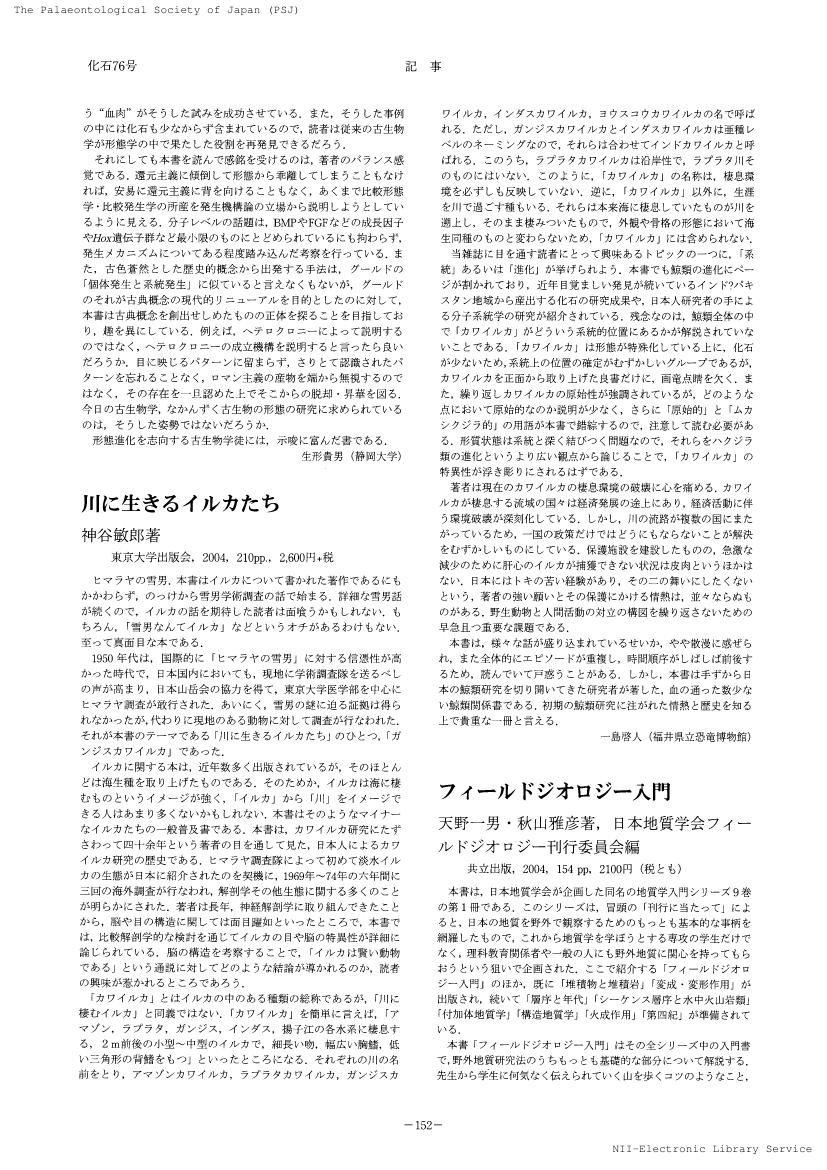- 著者
- 鎮西 清高
- 出版者
- 日本古生物学会
- 雑誌
- 化石 (ISSN:00229202)
- 巻号頁・発行日
- vol.76, pp.152-153, 2004-09-22 (Released:2017-10-03)
- 著者
- 鈴木 正男 鎮西 清高
- 出版者
- 日本地質学会
- 雑誌
- 地質学論集 (ISSN:03858545)
- 巻号頁・発行日
- no.8, pp.173-182, 1973-03-31
黒曜石は,ガラス質であるから,フィッション・トラック法による年代測定の試料として,実験操作,計数操作が容易で測定しやすい試料の一つである。これまで当研究室で得られた測定値の多くは,K-Ar法による測定値とよい一致を示す(KANEOKA and SUZUKI, 1970)けれども,中には,他の地質学的データと矛盾する値も測定されている。このような測定値の得られた試料は,黒曜石噴出後の熱的影響あるいは二次的影響が考えられる(KANEOKA and SUZUKI, 1970)。今回,新潟油田地帯で採取された黒曜石は,地質学的にみて,新第三系に由来する地層に含まれていたものである。これらの試料では,自発核分裂飛跡の部分的消失がみられ,この結果,自発核分裂飛跡の計数効率が大幅に減少して,若い年代が得られた。こうした若すぎる年代を補正するため,加熱による誘発核分裂飛跡の消失実験を行ない,補正曲線を各個試料について作成した。フィッション・トラック法による年代測定と,核分裂飛跡消失実験とを通じて以下のような結論を得た。i)自発核分裂飛跡の大きさの分布が単峰性であり,平均径が,誘発核分裂のそれと均しい場合(U1),測定された年代は,黒曜石が噴出した年代,または,臨界温度・熱条件以上に加熱された年代を意味する。ii)自発核分裂飛跡の大きさの分布が単峰性であり,平均径が,誘発核分裂のそれより小さい場合(U2),測定された年代は,黒曜石が噴出した年代,または,加熱された年代より著い年代を示すことになる。この場合,加熱実験により待られた補正曲線を用いて補正された年代が真の年代を示す。この際の加熱は,臨界温度・熱条件以下の加熱を意味する。FT 405,406,407MSの試料から得られたデータによれば,これらの試料は,30〜40℃/10^6yearsのthermal historyをもつと判断され,単に熱的影響だけでなく,二次的加水や,再結晶等の影響による自発核分裂飛跡の部分的消失も考えられる。iii)自発核分裂飛跡の大きさの分布が二峰性の場合(B),大きい飛跡の分布の平均径に基づいて得られる年代は,加熱された時から現在までの時間を示し,小さい飛跡の分布の平均径に基づいて得られる年代は,噴出から加熱までの時間の縮小された時間を示す。後者の年代をii)で述べた補正をほどこして得られる年代が,およその噴出した時から加熱された時までの時間を示す。結局,加熱から現在までの年代と,補正された噴出から加熱までの年代とを合計した年代が噴出年代を示すことになる。この場合の加熱もii)と同様,臨界温度一時間条件以下である。iv)核分裂飛跡の平均径の減少とそれに由来する飛跡密度の減少は一次関係ではない。この事実は,二次的(熱,加水等による)影響が単に,飛跡距離の一次関数的減少に帰結するのではなく,飛跡の三次元的な物理化学的変性に帰結することを意味する。この現象を他の天然鉱物・ガラスについて検討する必要がある。v)核分裂飛跡の二次的変性を厳密に究明することによって,その試料の経てきたthemal historyを解明することが可能である。そのためには,長期的な加熱による飛跡消失実験を行なう必要がある。
1 0 0 0 OA カキの古生態学 (1)
- 著者
- 鎮西 清高
- 出版者
- 日本古生物学会
- 雑誌
- 化石 (ISSN:00229202)
- 巻号頁・発行日
- vol.31, pp.27-34, 1982-06-21 (Released:2017-10-02)
Some paleoecologic aspects of oysters are discussed, giving special emphasis on the adaptive strategy of Crassostrea to the soft muddy bottom. Crassostrea is most abundant in the muddy intertidal facies despite their sessile and suspension feeding habit. Muddy bottom environment seems unfavorable for oysters because it offers very few basis of attachment, and gives continuous danger of suffocation by rapidly accumulating mud. Crassostrea surmounts these difficulties in living on mud, and becomes dominant in this environment. The basic strategy of Crassostrea for the survival in the muddy bottom is considered to be their gregarious tendency to constitute the densely aggregated colony. The colony supports the individual shell to stand above the surface of mud, and gives the firm basis for the attachment of later generations. The later generations grow on the colony, thus manage to keep living animals atop the rising mud level. Formation of the biohermal reef is the consequence of this characteristic behavior of Crassostrea. Nongenetic variations in shell morphology are conspicuous among Crassostrea individuals. The shell outline of fossil and living Crassostrea gigas is not controlled by the population density, but is probably related to the position of the shell : individuals in the upright position tend to be elongated irrespective of their density, and those lying on the bottom are usually more rounded. The population density apparently affects the individual shell size. Where the density is low, shells are very large, while they are small in densely populated reefs. The relationship may be explained by the competitive effect in the allocation of limited food supply.
1 0 0 0 OA カキの古生態学 (1)
- 著者
- 鎮西 清高
- 出版者
- 日本古生物学会
- 雑誌
- 化石 (ISSN:00229202)
- 巻号頁・発行日
- no.31, pp.27-34, 1982-06-21
- 被引用文献数
- 4
Some paleoecologic aspects of oysters are discussed, giving special emphasis on the adaptive strategy of Crassostrea to the soft muddy bottom. Crassostrea is most abundant in the muddy intertidal facies despite their sessile and suspension feeding habit. Muddy bottom environment seems unfavorable for oysters because it offers very few basis of attachment, and gives continuous danger of suffocation by rapidly accumulating mud. Crassostrea surmounts these difficulties in living on mud, and becomes dominant in this environment. The basic strategy of Crassostrea for the survival in the muddy bottom is considered to be their gregarious tendency to constitute the densely aggregated colony. The colony supports the individual shell to stand above the surface of mud, and gives the firm basis for the attachment of later generations. The later generations grow on the colony, thus manage to keep living animals atop the rising mud level. Formation of the biohermal reef is the consequence of this characteristic behavior of Crassostrea. Nongenetic variations in shell morphology are conspicuous among Crassostrea individuals. The shell outline of fossil and living Crassostrea gigas is not controlled by the population density, but is probably related to the position of the shell : individuals in the upright position tend to be elongated irrespective of their density, and those lying on the bottom are usually more rounded. The population density apparently affects the individual shell size. Where the density is low, shells are very large, while they are small in densely populated reefs. The relationship may be explained by the competitive effect in the allocation of limited food supply.
- 著者
- 鎮西 清高
- 出版者
- 日本古生物学会
- 雑誌
- 化石 (ISSN:00229202)
- 巻号頁・発行日
- no.56, 1994-06-30



